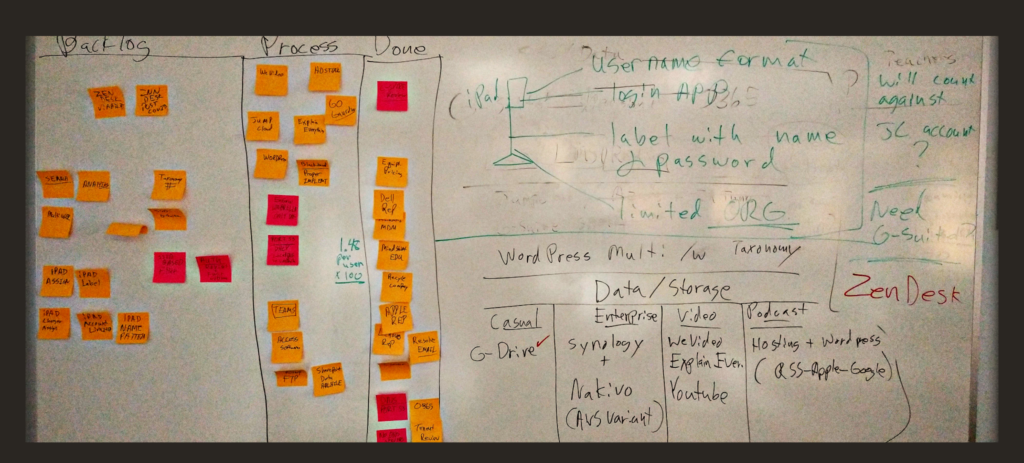A HIFLEX Opportunity
By Anthony DePrato, CISSP, CSM, Chief Technology Officer, St. Andrew’s Episcopal School, Ridgeland, MS
In early 2020 when the COVID-19 (C19) Pandemic began to hit the US K-12 education market, we had a head start on the problem. Unfortunately, many schools squandered the advantage due to rigid policies, static budgetary processes, and situational denial. With a network of world-class schools informing my decisions, I helped design C19 programs at two independent schools in the USA. I took advantage of the head start and innovated toward outcomes that would improve teaching and learning beyond the chaos. This article is a short reflection on the work my team and I accomplished at St. Andrews’s Episcopal School in Mississippi.
The Mission
My new campus in Mississippi had just survived round one of the C19 disruptions. A few of the key players on their team had moved on (this period was exhausting for many), and the technology side of the operation needed to focus on leadership.
Knowing the stakes and the need to maintain enrollment in a private school during a tough economy, I developed a mission statement to guide the problem-solving:
- Value @ Home
- Value @ School
- Value after the Pandemic
Whatever technology we invested in would need to meet all these criteria. A structure soon developed that eliminated most of the available hardware, software, and services. Here is an example of the mission in practice.
Cameras and streaming solutions were flooding the K-12 education space. Anecdotal technology referrals would come in often. Most of them were from other schools, touting a solution that would be a gamer changer. These were anecdotes, and we needed more stats and data to make a strategic decision.
Being able to say “No” is a superpower that I possess. I said “No” so frequently that I should have had it engraved on my desk.
Regarding cameras and streaming, we would ask:
- Is this solution portable between the classroom and the home?
- Can teachers easily set up the equipment and use it without support?
- Will this solution work with previously established tools and curriculum?
If all three answers were “Yes,” we would consider the solution.
Like many schools, we applied for grants and funding. Our paperwork was very efficient because we could easily support the request by stating unequivocally that our purchases would support teaching and learning anywhere and in any scenario as long as the internet was operational. There was very little waste in our procurement, and we planned on using this equipment for many years (pandemic or no pandemic).
Facing chaos is easier if you have standards to fall back on. There was little time to gamble, and the funding was finite. If we went all in on technology, we had to make it work.
The Budget
Like many independent schools, my school had little time to develop a unique pandemic budget. Imagine creating a budget for an event that is not fiscal, has no deadline, and could increase or decrease in severity. Resourcing solutions during the pandemic was a moving target.
We had a list of solutions that we wanted. All of them were vetted, even for security, and I personally pushed back on anything that was “free.” I knew the trade-off with “free” was security and accountability. An easy solution now, a lawsuit later, no thank you.
I reached out to vendors and licensed distributors. Using sources like Amazon was a poor value proposition during the pandemic. Prices were high, and the only support was getting a refund. We needed partners; I found partners.
The goal was to create vendor relationship solutions that would span years after the pandemic. In addition, I wanted predictable costs and cash flow. Partners for software and services were asked to submit options for three and five-year contracts, fixed pricing terms, dual payment strategies[1], and early notice of price increases.
We improved cash flow, stretched grant money further, and created an ecosystem of resources teachers, students, and families could use during and after the pandemic. When the K-12 community knows a resource is a long-term investment, they are more likely to learn and use it.
The HIFLEX Solution
We developed something we termed “HIFLEX”. I have a video and podcast explaining it in detail. I will link those below[2]. The solution is highly flexible and hybrid flexible.
To explain the solution quickly and concisely to teachers, students, and parents, I coined the phrase, “The iPad is a person in your classroom.”
If you have ever used a professional video conferencing suite, you would have noticed that the camera and audio system join the meeting as a person and takes the place of an individual human host.
This concept was the same, except we used iPads as the video source and a variety of solutions for the audio.
The audio was interesting. The classrooms and the home environments were different. The approach was to have an ample supply of solutions on hand. The most popular audio gear was a Yeti microphone. We arranged for them to be portable (@ home and @ school).
We also deployed a few simple solutions that allowed teachers to use their laptop microphones while rotating the laptop 360 degrees on a low-cost podium.
We included the option to have a lightweight visualizer/document camera for those who wanted to use handwriting and analog resources.
The faculty used this HIFLEX solution in ways I had not imagined. With both a laptop webcam and iPad camera in the room, two video sources were possible. iPads had a special stand with arms that allowed for a true spherical implementation creating depth and motion when required.
As a campus, we quickly emerged from “how do we do…?” to “how can we do…?” and “I want to do…”.
The Concurrent Chaos No One Knew About
There was nothing easy about developing the HIFLEX solution. The majority of people only see the end-points, like iPads and microphones. They only see some of the changes needed to get all this gear working on-campus in a hybrid scenario. They do not see the difference in workflow required to support hundreds of users off campus with a small team. The complexity of the security and sharing protocols between the school and the vendors was also a major concern.
Here are a few concurrent problems we had to solve:
- SSO for all significant platforms was a disaster and needed rebuilding
- Zero-touch onboarding of all accounts (we proudly still onboard 90% of teachers and students before their first day on campus)
- RADIUS implementation had to be scrapped and reconceived
- Access Points in some areas needed to be re-deployed to areas that could support social distancing
- Bandwidth was insufficient
- Numerous network bottlenecks were detected and required rapid cable and switch replacement
- Printing needed to be eliminated when sharing of objects was prohibited
- The School databases needed full auditing for roles and access with new two-factor authentication standards to offset the risk of @ home users
- Budgets needed reclassification for services instead of assets
- Business Association Agreements needed a full review to ensure data compliance and standards
The approach to dealing with these and other issues was highly structured. From the top level, I implemented an Eisenhower Matrix[3]. As each project within that matrix needed addressing, I created an Agile Scrum board to ensure completion and feedback.

The story of finding opportunities during the pandemic is not a technology story. It is about working with teams, staying on mission, and creating long-term holistic value. When it ended, we were not surrounded by useless hardware, temporary systems, or fiscally wasteful contracts. We had new classrooms, new pathways, and new opportunities. The difference between technology and educational technology is simple. Technology fills a gap or need. Educational technology creates opportunity. We did that, and we did that well.
References and About Author
[1] A dual payment strategy spreads the cost of a service over two fiscal years; the first payment is made within 30 days of the end of the fiscal year; the second payment is made within 30 days of the renewal date; the vendor is applying a credit to the account to help maxmize budget surplus
[2] HIFLEX video https://bit.ly/3Fc1PEP & HIFLEX podcast discussion https://bit.ly/3OINwLf
[3] This article explains The Eisenhower Matrix, https://bit.ly/3FdGWcD
Anthony DePrato is currently the Chief Technology Officer at St. Andrew’s Episcopal School in Jackson, Mississippi. He can be contacted via LinkedIn at, https://www.linkedin.com/in/tdeprato/

